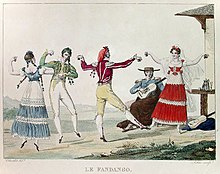
Flamenco is an art form based on the various folkloric music traditions of southern Spain, developed within the gitano subculture of the region of Andalusia, and also having historical presence in Extremadura and Murcia. In a wider sense, the term is used to refer to a variety of both contemporary and traditional musical styles typical of southern Spain. Flamenco is closely associated to the gitanos of the Romani ethnicity who have contributed significantly to its origination and professionalization. However, its style is uniquely Andalusian and flamenco artists have historically included Spaniards of both gitano and non-gitano heritage.

In Spain, music has a long history. It has played an important role in the development of Western music, and has greatly influenced Latin American music. Spanish music is often associated with traditional styles such as flamenco and classical guitar. While these forms of music are common, there are many different traditional musical and dance styles across the regions. For example, music from the north-west regions is heavily reliant on bagpipes, the jota is widespread in the centre and north of the country, and flamenco originated in the south. Spanish music played a notable part in the early developments of western classical music, from the 15th through the early 17th century. The breadth of musical innovation can be seen in composers like Tomás Luis de Victoria, styles like the zarzuela of Spanish opera, the ballet of Manuel de Falla, and the classical guitar music of Francisco Tárrega. Nowadays commercial pop music dominates.
Music of AndalusiaThe Music of Andalusia encompasses a range of traditional and modern musical genres which originate in the region of Andalusia in southern Spain. The most famous are copla and flamenco, the latter being sometimes used as a portmanteau term for various regional musical traditions within Andalusia. Today, Andalusia has a rich and thriving musical scene, which draws from its own musical traditions as well as from external influences such as salsa, jazz or pop music.
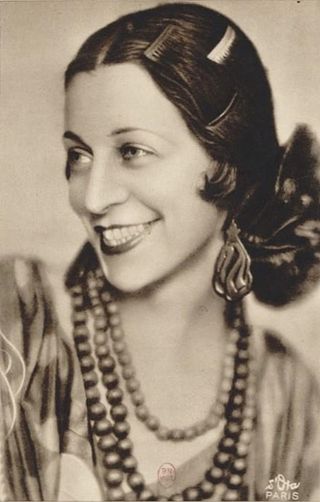
Antonia Mercé y Luque, also known as La Argentina, was an Argentine-born Spanish dancer who created the neoclassical style of Spanish dance. She was widely regarded as one of the most famous Spanish dancers of the 20th century and was nicknamed the "Queen of the Castanets" and the "Flamenco Pavlova."
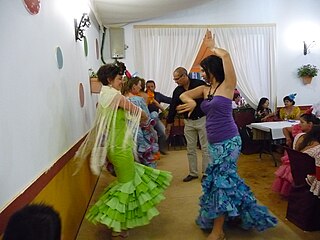
Sevillanas are a type of folk music and dance of Sevilla and its region. They were derived from the Seguidilla, an old Castilian folk music and dance genre. In the nineteenth century they were influenced by Flamenco. They have a relatively limited musical pattern but are rich in lyrics based on country life, virgins, country towns, neighborhoods, pilgrimage, and love themes.
Género chico is a Spanish genre of short, light plays with music. It is a major branch of zarzuela, Spain's form of popular music theatre with dialogue, and differs from zarzuela grande and most other operatic forms both in its brevity and by being aimed at audiences of a wide social spectrum.

The Three-Cornered Hat is a ballet choreographed by Léonide Massine to music by Manuel de Falla. It was commissioned by Sergei Diaghilev and premiered in 1919. It is not only a ballet with Spanish setting but one that also employs the techniques of Spanish dance instead of classical ballet.
Malagueñas is one of the traditional styles of Andalusian music (flamenco), derived from earlier types of fandango from the area of Málaga, classified among the Cantes de Levante. Originally a folk-song type, it became a flamenco style in the 19th century. It is not normally used for dance, as it is generally interpreted with no regular rhythmic pattern, as a "cante libre". It has a very rich melody with virtuous flourishes and use of microtones. Its guitar accompaniment is normally played in open position first inversion giving E for the tonic, which can be transposed by using a capo.

The jota is a genre of music and the associated dance known throughout Spain, most likely originating in Aragon. It varies by region, having a characteristic form in Aragon, Mallorca, Catalonia, León, Castile, Navarre, Cantabria, Asturias, Galicia, La Rioja, Murcia and Eastern Andalusia. Being a visual representation, the jota is danced and sung accompanied by castanets, and the interpreters tend to wear regional costumes. In Valencia, the jota was once danced during interment ceremonies.

José Tejada Marín, known as Pepe Marchena and also as Niño de Marchena in the first years of his career, was a Spanish flamenco singer who achieved great success in the ópera flamenca period (1922–1956). Influenced by singers like Antonio Chacón, he carried to the extreme the tendency to a more mellow and ornamented style of flamenco singing. Owing to his particular vocal conditions and singing style, he excelled mainly in palos (styles) like fandangos, cantes de ida y vuelta and cantes libres, contributing to making them the most popular flamenco styles in the era of the ópera flamenca, and created a new cante de ida y vuelta, the colombiana, later recorded by many other artists like El Lebrijano or Enrique Morente. He was also the first flamenco singer to use an orchestra to accompany flamenco singing, though later he returned to the guitar.

Castanets, also known as clackers or palillos, are a percussion instrument (idiophone), used in Spanish, Calé, Moorish, Ottoman, Italian, Mexican, Sephardic, Portuguese and Swiss music. In ancient Greece and ancient Rome there was a similar instrument called the crotalum.
The cante flamenco, meaning "flamenco singing", is one of the three main components of flamenco, along with toque and baile (dance). Because the dancer is front and center in a flamenco performance, foreigners often assume the dance is the most important aspect of the art form — in fact, it is the cante which is the heart and soul of the genre. A cante singer is a cantaor or cantaora.

Pedro Albéniz y Basanta was a Spanish pianist and composer. He was unrelated to Isaac Albéniz.
A Rondeña is a palo or musical form of flamenco originating in the town of Ronda in the province of Málaga in Spain.
Sebastián Cerezo was a Spanish dancer from La Mancha. In 1799, he was credited by Zamácola y Ocerín as one of the earliest and best dancers of the bolero, a Spanish dance developed between 1750 and 1772, which became very popular in Madrid, La Mancha, Andalusia and Murcia in the 1780s. According to Zamácola y Ocerín, Cerezo danced slowly and his particular way of dancing marked the definitive transition from seguidilla to bolero. This original slow way of dancing was promoted by Murcian dancer Requejo around 1800 in response to the faster style of bolero dancing that had become popular over the years.
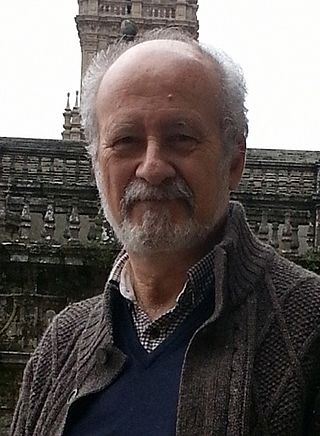
José Luis Turina is a Spanish composer, grandson of Joaquín Turina.

Son mexicano is a style of Mexican folk music and dance that encompasses various regional genres, all of which are called son. The term son literally means "sound" in Spanish, and is also applied to other unrelated genres, most notably son cubano.
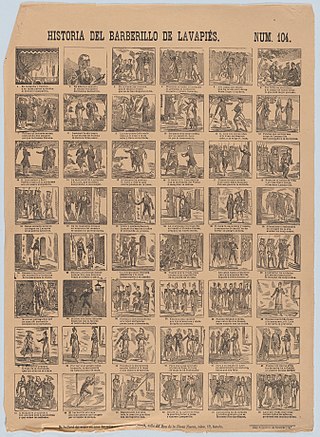
El barberillo de Lavapiés is a zarzuela in three acts (Op.56) by Francisco Asenjo Barbieri. The libretto, in Spanish, is by Luis Mariano de Larra. The first performance took place at the Teatro de la Zarzuela in Madrid on 18 December 1874, and it became one of the most well-known zarzuelas. Translated as The Little Barber of Lavapiés, the title refers to the occupation of one of the main characters and the humble and neglected area of the Spanish capital called Lavapiés where it is set.

Bolero is a Spanish dance in 3/4 time popular in the late 18th and early 19th centuries. It originated from the seguidilla sometime between 1750 and 1772, and it became very popular in Madrid, La Mancha, Andalusia and Murcia in the 1780s. Bolero was performed as a solo or partner dance with a moderately slow tempo, accompanied by guitar and castanets, and with lyrics in the form of the seguidilla.

Cumbia is a musical genre and folk dance from Panama.
